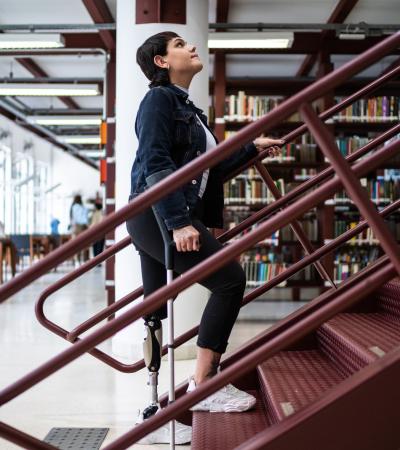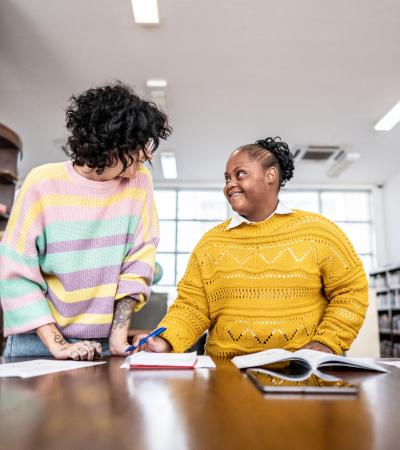As the initiative’s evaluator, we’ve been speaking with patrons of small and rural libraries to learn about their perspectives on these projects. In this blog post, we share what we learned through a conversation with three library users who identify as disabled. We asked these patrons to share what they've noticed and what they'd still like to see. While none of the three patrons identified with the disabilities their library's project was focusing on, all three were excited to see the changes being made to make their library more inclusive to all users. At least two of them noticed some clear changes in the experience of other disabled library patrons.
All patron names have been changed. Since race, gender, and culture were not a focal area of our study, we've used non-gendered names from a wide variety of cultural backgrounds.

Patron #1: Ashwini
Ashwini is a dedicated library user. Like people with many different disabilities (including those related to mobility, executive functioning, and sensory processing), their disability makes it difficult for them to leave their house. They credit two resources for enabling their use of the local library.
First, they're a big fan of the "phenomenal" Libby app, since they can borrow e-books and audiobooks from home. They also appreciate that e-books automatically return themselves, which is a helpful support for executive functioning.
Second, they love that their library maintains an up-to-date calendar. They really enjoy programs, classes, and recurring events where they see the same people — but visiting the library requires considerable planning ahead. The online event calendar makes it possible for them to see which days they will most enjoy the library.
Their library received an LTC grant and used the money to focus on neurodivergent children and adolescents. In partnership with the local school district, the library curated VR hardware and software bundles that included life skills programs and adaptive curricular programs. They also developed a number of new sensory initiatives.
Ashwini had not yet used the new sensory initiatives, but was happy to see them put in place. "I'm all for multiple options, different ways to engage," they say. And they love seeing "the fruits" of efforts being made to engage more people. They hope that future efforts include more virtual resources—especially e-books and audiobooks—and ASL classes at the library to make the whole community more welcoming to its Deaf members and more sensitive to their needs.
Patron #2: Berhane
When Berhane retired, they started reading recreationally as a hobby, which drew them to their local library. They found that "the library really does attract people who just want to explore their creative side with no expectations," and became a regular during open art studio sessions. Berhane now visits the library at least once a week, and often twice or more.
Berhane's library has been very focused on "becoming a focal point for the community, particularly people who are neurodiverse." The library used their LTC grant to focus primarily on adults with intellectual and developmental disabilities, and to create art classes, concerts, and other programs that could bring everyone together while also attending to the nuance and uniqueness of each person's needs. Berhane, who had attended the community conversation the library held to gather patrons’ input on how to best put the grant to use, was a big fan of the thoughtful changes being put into practice.
Berhane does not identify as neurodivergent. But the creative sessions they attend are an example of the library's focus, and the sessions are welcoming to a group of people who would not have met otherwise. Half of the group are Berhane's age or older, while half are young adults. The regulars have become quite close. "[We] have this incredible conversational dynamic, that I don't [even] have necessarily in my own family," Berhane shares.
The library's openness to a neurodiverse population has also impacted Berhane directly. Some people who might not have felt as welcome before are now a regular presence at the library, and Berhane is on friendly terms with them. They’ve also developed specific relationships because of their librarian, who is "very good about trying to encourage opportunities where we get to have some direct one-on-one interaction, not scripted, just kind of with the flow." They described collaborating closely on a project with one person the librarian introduced them to. It turned out that they shared common interests and complementary skill sets.
Berhane describes themself as having a disability, specifically limited hearing and mobility. The library is in an older building, and they hope that future improvements can include a more reliable elevator and more accessible parking. They'd also like to see some quiet meeting spaces available at the library to facilitate more new relationships, like the ones they have so loved forming. As they pointed out, those spaces would make the library even more welcoming for people who are hard of hearing and for people who are sensitive to sound.
Patron #3: Cameron
Cameron lives in between three small rural libraries and works an hour away, which means they regularly visit four different libraries. They prefer working at a library rather than at home, and their favorite library has less noise and less light than the others — which is important for their sensory sensitivities.
Cameron's favorite library used their LTC grant to focus on mobility needs. They changed the height of several desks to be accessible to wheelchair users, and moved around the circulation desk and several other areas to increase the functional width of corridors by the accessible entranceway and bathroom. While Cameron doesn't regularly use either this entrance or this bathroom, they had noticed some changes and appreciated that people seemed to be moving around more smoothly.
Cameron also likes this library because the staff are "very responsive." This library, they noted, is located in a small, poor town close to a much wealthier metropolitan area. All the same, Cameron prefers this library to the metropolitan one, because "they really work hard to listen to what people need." They are pleased to see their library making changes based on what they hear (rather than on the basis of their assumptions).
Let’s Put it to Work!
Have something to say about your library’s accessibility work? Please reach us at programminglibrarian@ala.org to share your experiences and suggestions!
About this Article
This article is part of a series of blog posts exploring how libraries that received funds through ALA's LTC: Accessible Small & Rural Communities are working to better meet the needs of patrons with disabilities. In other posts in this series, we provide a general overview of the accessibility projects these libraries have launched, look at attempts to put the disability rights movement’s ethic of “Nothing About Us Without Us” into practice, consider efforts focused on neurodivergent patrons and older adults, and look at how small and rural libraries are creating accessible community conversations. For more on how libraries can become more accessible to patrons with disabilities, see the collection of resources we assembled. And for more information about LTC, see our historical overview of this initiative.



